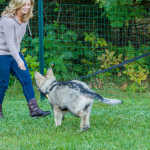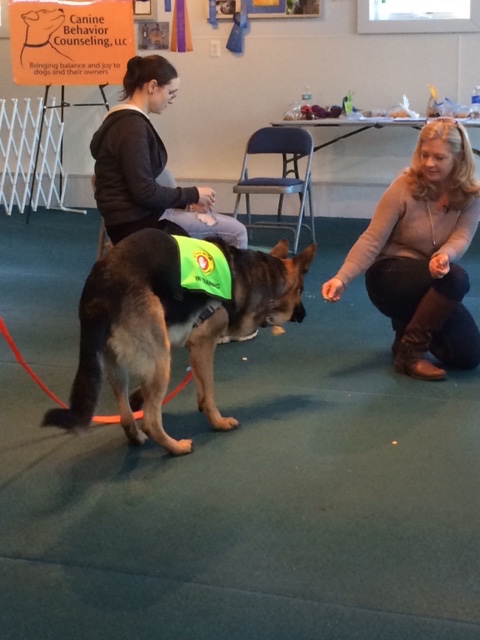This is the fifth of a five part segment, to help dog owners with insecure dogs that act aggressively to strangers. A practical guide to helping owners with dogs who rush and bark at people through windows, fences, at the front door and on leash.
The steps we discussed in weeks prior are:
Step 1. Management; prevent your dog from practicing the unwanted behavior.
Step 2. Desensitization and counter condition; change how your dog feels.
Step 3. Bite Prevention; understanding your shy dogs Distance Cues.
Step 4. Emotional Control Exercises; helping your dog have better impulse control.
Step 5. Adding Criteria; discussed below.

Adding Criteria in general: Now that your dog has better emotional control in quiet settings, I recommend you begin to add some criteria to your training in very small steps. When training fails it is often because we humans want the behavior to be corrected or stopped without changing how the dog feels. Small criteria additions would be training your dog in your driveway or yard, staying a safe distance from the street. If you are in a city environment, then begin this step inside the house near a window, inside the front door or in the back yard. Another option is to drive your dog to a safe location at the end of your street where you have a friend waiting with instructions on how to toss a treat at your dogs feet, and then toss one further away as you walk a bit. Have a successful short training session then return home to relax.
Adding Criteria with guests: If your dog is highly aroused inside the front door, begin your training with a guest outside your home or down the street, as your dog needs to be in a thinking brain for desensitization to work. If your dog is on a leash, be sure the leash is slack and the handler follows the dog, rather than directing the dog’s movements. This gives your insecure dog a choice in how close he wants to be to the stranger, which allows desensitization to be effective, and it allows you to constantly see how your dog is feeling. Pay attention to your dog and note the difference in his body language with guests in your home compared to on the street. BEGIN training where your dog is calmer. If your dog gets stiff, begins breathing fast, growling, or barking, simply take a short break and move farther from his territory. When you begin again, increase the number of times you toss the treat far away so the dog does not feel like you are trying to “trick” him, as this will halt any desensitization you expect to accomplish. This process may take three or four session with the same person down the street before your dog can relax, that is fine, just go at your dogs pace.

Adding Criteria in your home: As long as you are seeing your dog with a relaxed face and body outside your home, you can continue with your guest entering your home first, ahead of you and your dog, then continue the treat and retreat game, with your dog on a slack leash remembering the dog has a choice.
Regardless of how the people are positioned (standing, sitting, moving etc.) the dog is free to approach or avoid at any time. The dog may choose to come into a person’s space or not, may choose to enter and stay in that space, or may choose to enter and then leave. This process helps the dog feel safe because he is in control, preventing him from sliding into fight mode. When your dog feels safe, he will be able to think and learn and associate your guest with a positive association.
Time frame: Each dog will progress at a different pace and they can only go at their pace. Factors that change this time frame are how the person smells, how many guests you have, how tall they are, male or female, how fast they move, if they make direct eye contact, if they are nervous, if they lean over the dog too far or stomp their feet. If your dog goes over his comfort level, he may lunge and or snap, I do not recommend you punish your dog, simply slow the progression down until you reduce your dogs fear.
Reducing your dogs fear of humans will be a process if you own a shy or insecure dog. Your guests or friends participating in the desensitization process should be coached to not approach the dog, but rather wait for the dog to approach them to begin the treat and retreat game. Giving the dog a choice in the relationship will keep him feeling safe and in control so he is able to change how he feels about humans.



